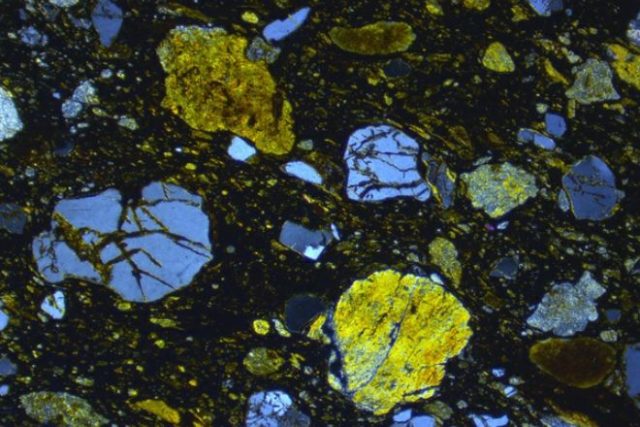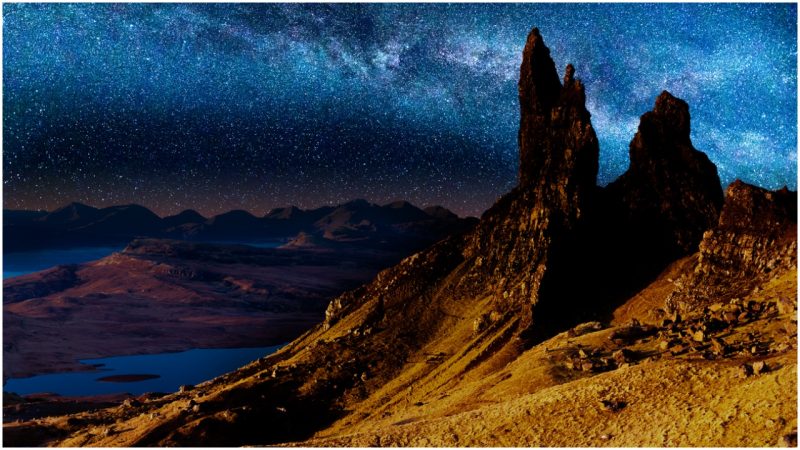In a mission to find out more about volcanic rocks on the Isle of Skye, situated just northwest of the Scottish mainland, geologists have reported discovering evidence of traces of a meteorite impact approximately 60 million years ago and a set of unusual minerals never seen on Earth.
The minerals are deemed to have come from most likely the oldest meteorite ever to have hit the British Isles. The news excited the scientific community in December 2017.
The minerals, such as vanadium-rich and niobium-rich osbornite, have been discovered in an ejecta layer, slightly more than three feet thick, at the bottom of a millennia-aged lava flow. Analysis of the samples has confirmed that the strange minerals have never before been traced elsewhere on Earth. However, particles from some of the minerals have been previously retrieved in a mission carried out by NASA, one which began in 1999. Within the mission, it was the Stardust space probe that was used to successfully take samples of cosmic dust from the Wild 2 comet, returning the samples to Earth in 2006, the year when the mission concluded.
In the case of the Scottish finding, unlike the particles retrieved from space, the osbornite seems to have once been part of the meteorite itself. It was detected unmelted, according to what geologists have stated. Analysis of samples have also pointed to the presence of reidite, which would be a type of zircon delivered after extreme high pressures, and commonly associated with impact points of meteorites. Barringerite and iron have also been found in the retrieved samples.

The strange set of minerals has been identified at two locations so far, over four miles away from each other, and at both sites, geologists have managed to recover a similar mix of elements. They have affirmed that the meteorite impact took place approximately 60 million years ago.
The expedition was led by Dr. Simon Drake, an associate lecturer at the Department of Earth and Planetary Sciences at the Birkbeck University of London. Drake came across the groundbreaking discovery in Skye along with Dr. Andy Beard, his colleague from the same department. At the beginning of their expeditions to Skye, they also had to move through a peat bog, an experience probably not the most pleasant one, or as Dr. Drake has described it: “We were sinking in up to our thighs.”
“I distinctly recall saying to Andy Beard, ‘This had better be worth it,’ ” remarked Dr. Drake, which apparently was just that. According to the researchers, the ancient meteorite may have had a significant role in the evolution of the Isle of Skye.
According to Dr. Drake’s statements for BBC Radio Scotland, measuring the extent of the impact area from the meteorite has still not been possible. Besides confirming that there are two sites pointing to traces of the event, Drake has also remarked that there are two more potential sites on Skye yet to become a subject of investigation.
Dr. Drake commented: “One of the things that is really interesting here is that the volcanological evolution of the Isle of Skye has always been considered to have been started with what’s called a volcanic plume, an enormously large bulk of magma which has come up under what then was the crust that Skye was on.” He adds: “We are now suggesting that this may well have been assisted by a meteorite impact.”
In a statement made for Newsweek, Drake says: “Whilst we can’t say that the volcanological evolution of Skye was started by a meteorite, we think it was definitely a driver for the impact.”

Initially, the geologists thought that they had stumbled upon a regular lava deposit. However, it was the later analysis helped by electron microprobe that showed the minerals were deployed in the area directly from space.
These findings come only a year after another announcement made by scientists, that there are proofs of an ancient crater made by a meteorite lurking beneath Scotland, a unique example in the United Kingdom. As the BBC reported, evidence of the ancient meteorite impact also consist of deposits of green molten fragments of rock and red sandstone, all pressed in between other sandstone layers as old as some 1.2 billion years.
